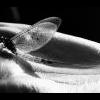-
Content Count
726 -
Joined
-
Last visited
Content Type
Profiles
Forums
Calendar
Everything posted by dwiltshire
-
Last week, the fish on my local streams were fixated on small sedge and were still very wary of the Green Drake fluttering about. I found these patterns very useful: ...and a very sparsely-winged sedge: Hook: Varivas 2200BL #16 Thread: 14/0 Sheer, primrose Butt and rib: Funky Flash, pearl Body: Mink Thorax: Hare Wing: either CDC or Yearling Elk Hopefully they'll be snacking on the Green Drake this evening.
-
Thanks for all the comments
-
Can coloured hooks can make a difference, even on a dry fly? I believe they can... These parachute emergers are tied on Partridge 15G: Hook: Partridge 15G #18 Thread: Sheer, 14/0 tan Dubbing: Spectrablend, ginger Post: Funky Fibre, light green Hackle: Golden Badger
-
Thanks for the comments
-
That has a little bit of everything... very nicely tied
-
Very small plumes are great for CDC loop emergers. For stunning CDC with very long barbs and high barb count, try Lucian: http://www.flytying.ro/
-
You certainly could. I just prefer CdL for tails -perhaps a confidence thing. Try microfibbets too. We have a few bigger flies, and this will work well for LDOs tied on #14 - #18, but often it's the smaller flies that are of interest on my rivers.
-
One for the LDO (Baetis Rhodani) hatch: Hook: Partridge SLD #18 Thread: Sheer, 14/0, tan Tails: Coq de Leon Abdomen: Spectrablend, dark olive Wing: Natural CDC Hackle: Silver Badger
-
Hey, your version is a stunner. Those long tails and the biot body just scream "take!". Nice work
-
Sorry I haven't replied to comments / questions - been so busy! Do you find that having this on your fingers makes the tippet float, or can you take care of that with a degreaser like orvis original mud? I have got myself in the habit of used grease with my right hand and sinkant / mud on the other - then no contamination can occur. This has fewer turns. I carry both heavy and sparsely hackled parachites and paraduns. With CDC, just practice. It's a great material. As suggested, try a CDC parachute too:
-
I would apply floatant to the post and the hackle - only lightly though. ~D
-
For those tricky, picky surface feeders... Hook: Varivas 2210 #30 Thread: Sheer, 14/0 Rib: Darkened tying thread Thorax: Wapsi superfine, grey & brown Wing: CDC
-
Thanks folks. I used to, as many tyers do, tie the wing material along the hook shank and then use the thread to being the post vertical and in position. However, IMO this leads to unnecessry build up of the body - and let's face it, slim and light dry flies are a must. Therefore, by using this method, you obtain a much neater slimmer fly but can still end up with plenty of post - you have double the thickness in the post than you do around the hook shank (if that makes sense?). You could actually use just the first stagen where the post material s used to pick up the thread. However I turn it and pull it down so that it evetually wraps around the hook and back up for a few main reasons: 1) The post will be stronger and more durable - you will never have the post slip with this technique. 2) The wrap under the hook shanke helps shape the thorax. Several figure of 8 thread wraps either side on the post and then a couple around the post is all it takes. 3) I can get the post in the perfect position with very few wraps - infact the finished fly, with the whip finish probably has no more than 6 wraps around the post. For me, I find this gives a very delicate but durable fly with all the correct proportions. Use what suits - but I dare you to try it! Hope that helps Ray. Let me know if anything fails to make sense! Dave
-
I have just added the tying sequence for tying The Paradun to the River Fly Box: http://www.riverflybox.co.uk/paradun.html
-
I have just added the tying sequence for tying The Paradun to the River Fly Box: http://www.riverflybox.co.uk/paradun.html
-
I see what you mean. No, not a problem; the fly is pretty heavy and gets down well.
-
The whole fly will bounce along the bottom. I may be missing your thought process here???
-
Hook: Partridge SUD #10 Thread: Moser Powersilk, 10/0 olive Grub: Glo-Brite floss #12, fluo green Legs: Partridge Case: Hare in split thread & 2.5mm tungsten, black (Flat lead under body can also be added for additional mass)
-
Thanks folks Thanks Ray. I bought mine from Lawrence directly. Drop me an email if you're intrested and I'll dig out his address for you. Super sharp and wouldn't be without mine.
-
I have added a new fly to the River Fly Box: The GRHE Nymph. A no-nonsense bruiser; but effective! http://www.riverflybox.co.uk/grhenymph.html Cheers, Dave
-
I have added a new fly to the River Fly Box: The GRHE Nymph. A no-nonsense bruiser; but effective! http://www.riverflybox.co.uk/grhenymph.html Cheers, Dave
-
An alternative to the S-Loop nymph, this time using Barred Woodduck for the tails and loop. Great for fishing as an ascending nymph with a lift at the end of the drift - aiming for an induced take: Hook: Varivas 2120WB #14 Ballast: 1.5mm Tungsten Thread: Sheer 14/0, tan Body: Orvis Spectrablend, ginger Thorax: Orvis Spectrablend, light olive Rib: Tying thread Tail / Loop: Barred Woodduck
-
Take a look here: http://www.riverflybox.co.uk/cdcdun.html Hope it helps. Any problems, just shout
-
Thanks folks... Really pleased you like them. Your comments mean alot
-
Hook: Partridge SLD #16 / #20 Thread: Sheer 14/0, tan Abdomen: Orvis Spectrablend, cream Thorax: Orvis Spectrablend, peacock Wing post: Grey Funkyfibre Tails: microfibbets Hackle: Silver badger

